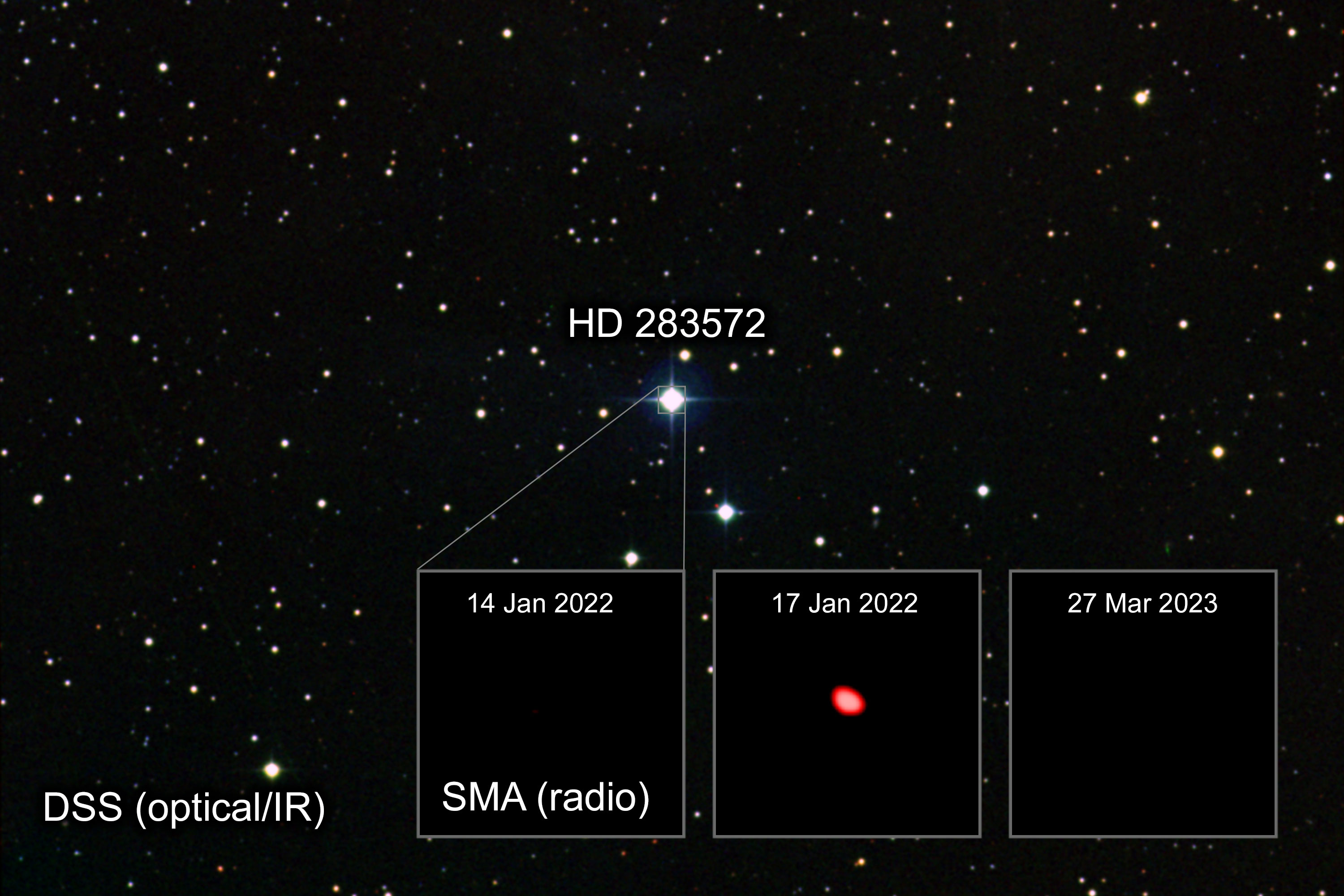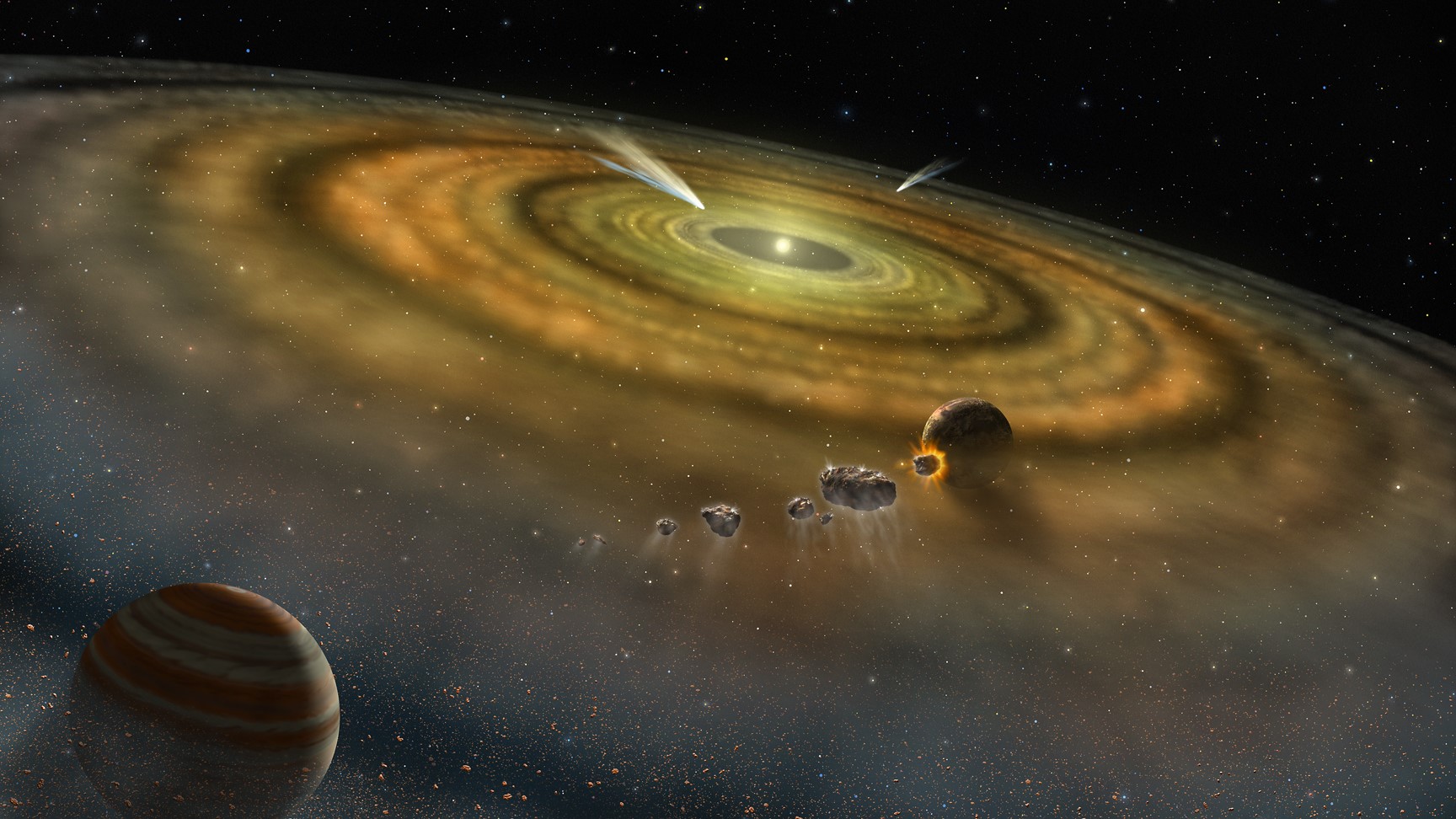A star's extreme outburst could be tormenting baby planets
"This was an immense event, equivalent to expending Earth's entire nuclear arsenal in about a millisecond, over and over again, for nearly half a day!"

An extreme eruption from a young star that resembles the sun suggests budding planets have to exist in a rather savage environment.
A team of scientists from the Center for Astrophysics (CfA) used the Submillimeter Array (SMA), an array of telescopes on Maunakea in Hawaii, to observe the young star HD 283572. The crew watched as HD 283572's brightness increased by hundreds of times over the course of just a few hours. This observed eruption ranks as one of the most powerful stellar flares ever seen.
Located around 400 light-years away, HD 283572 is around 1.4 times more massive than the sun — but at just under 3 million years old, it is over a thousand times younger than our star, which is around 4.6 billion years old. That means, when astronomers saw HD 283572, they witnessed it at the same stage of life the sun was in when it started forming planets, like Earth.
As a result, these findings could indicate that forming planets, including those of the solar system, must face turbulent conditions.
"We were surprised to see an extraordinarily bright flare from an ordinary young star," team leader and CfA scientist, Joshua Bennett Lovell, said in a statement. "Any potential planets developing in this system would have been hammered by the intense power of this flare. I wouldn’t want to grow up there!"
Related: James Webb Space Telescope makes rare detection of 2 exoplanets orbiting dead stars
Young stars are tightly wound springs
Stellar flares like those observed by Lovell and colleagues are thought to be created as stars rotate and tangle up their magnetic fields.
Just as a spring wound too tightly stores up kinetic energy that has to be released, the stored magnetic energy in these wound-up magnetic fields must be relieved. For stars, this causes bursts of accelerated particles to erupt through their surfaces and out into space.
Breaking space news, the latest updates on rocket launches, skywatching events and more!
Stellar flares accompanying this eruption of stellar matter, or plasma, can increase the brightness of a star by tens or hundreds of times and across a range of light wavelengths. Yet, spotting such flaring is still challenging because these events essentially happen at random, so there isn't a clear idea of when to direct a telescope at a star to catch its next temper tantrum.
This was certainly the case with HD 283572, which appeared dormant prior to its tremendous eruption.
"Every time we pointed the SMA back at the star after this flare, we saw nothing," Lovell explained. "Our findings confirm that these flare events are rare at millimeter wavelengths, but that these can be extremely powerful for stars at this young age."

Over a 9-hour period, the HD 283572 flare's energy reached levels millions of times greater than the energy released by similar flares measured in the vicinity of the solar system.
"This was an immense event, equivalent to expending Earth's entire nuclear arsenal in about a millisecond, over and over again, for nearly half a day!" SMA Project Scientist and team member, Garrett Keating, said in the statement. "If we account for the wavelengths of the star's light that the SMA did not observe, we expect it could have even been many times more energetic."
The team only spotted one flare from HD 283572, so we can't currently be sure what exactly triggered the massive explosion.
"Flares at these wavelengths are rare, and we had not anticipated seeing anything but the faint glow of planet-forming dust," said Keating. "It's a real puzzle, and there are a range of mechanisms that could be at play. Interactions with unseen companion stars or planets or periodic starspot activity are two possibilities, but what remains beyond doubt is how powerful an event this was."
Flares like this one are so powerful they can strip away atmospheres as they develop around young forming planets.
The discovery of such an energetic flare at this crucial period of a planetary system's life gives scientists a clue as to the kind of pressures Earth and its sibling planets would have experienced while forming some 4.5 billion years ago. The results could also hint at what extra-solar planets or "exoplanets" in earlier stages of their lifetimes may be experiencing right now.
The team behind this research is continuing to monitor HD 283572 to determine how often the young star erupts and to see whether this flaring could be affecting the growth of planetary atmospheres in the budding planets around it.
Additionally, a new SMA campaign will study other young stars similar to HD 283572 to determine their typical properties and flaring frequencies. By combining the SMA data with longer wavelength observations, the team said it also hopes to better understand the physics of these flares and the processes from which they stem.
The team's results have been accepted for publication in The Astrophysical Journal Letters, with a pre-peer review paper available at arXiv.

Robert Lea is a science journalist in the U.K. whose articles have been published in Physics World, New Scientist, Astronomy Magazine, All About Space, Newsweek and ZME Science. He also writes about science communication for Elsevier and the European Journal of Physics. Rob holds a bachelor of science degree in physics and astronomy from the U.K.’s Open University. Follow him on Twitter @sciencef1rst.

